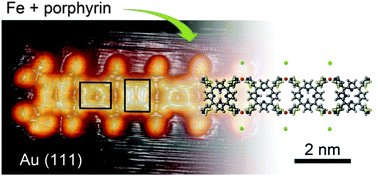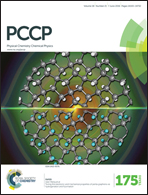Structural reconstruction and spontaneous formation of Fe polynuclears: a self-assembly of Fe–porphyrin coordination chains on Au(111) revealed by scanning tunneling microscopy†
Abstract
A self-assembled Fe–porphyrin coordination chain structure on a Au(111) surface is investigated by scanning tunneling microscopy (STM), revealing structural reconstruction resulting from an alternative change of molecular orientations and spontaneous formation of uniformly sized Fe polynuclears. The alternation of the molecular orientations is ascribed to the cooperation of the attractive coordination and the intermolecular steric repulsion as elucidated by high-resolution STM observations. Furthermore, chemical control experiments are carried out to determine the number of atoms in an Fe polynuclear, suggesting a tentative Fe dinuclear-module that serves not only as a coordination center to link porphyrin units together but also as a “dangling” site for further functionalization by a guest terpyridine ligand. The chain structure and the Fe polynuclears are stable up to 320 K as revealed by real-time STM scanning. Annealing at higher temperatures converts the chain structure into a two-dimensional coordination structure.


 Please wait while we load your content...
Please wait while we load your content...